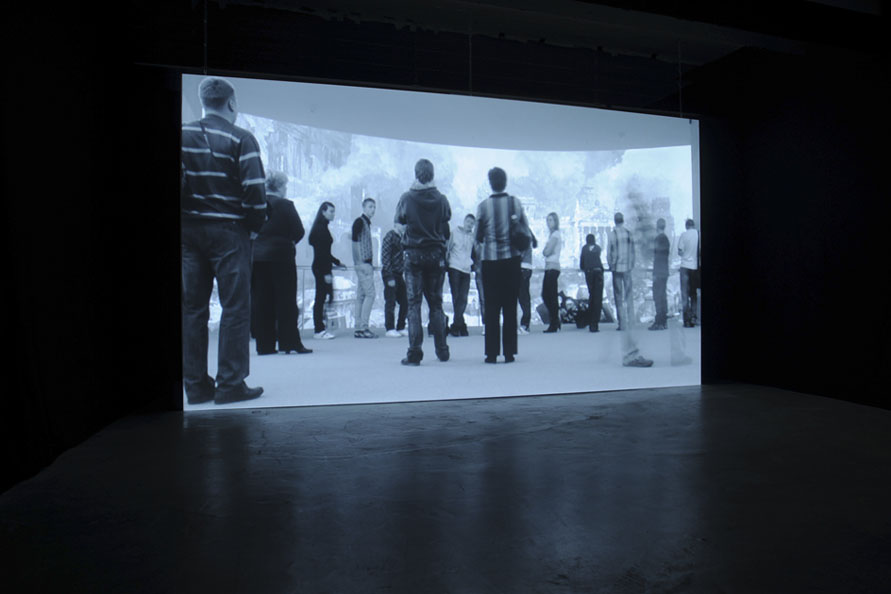
The Museum of the Great Patriotic War, Poklonnaya Gora, in Moscow is devoted to the commemoration of the victory of the Red Army over fascism in World War II. The gigantic building in the western part of the Russian capital was inaugurated in 1995, during the Yeltsin era. However, the decision for constructing such a memorial had, already been taken by the Central Committee back in 1957. Even in Russia 2.0, this symbolic place represents the heart of the post-communist official state policy, as the ceremonies of the anniversaries of the victory over Nazi Germany allways show.
The video work Sturm auf Berlin (Storming of Berlin) is based on one out of six battle dioramas, exhibited in the basement of the intensely frequented Poklonnaya Gora. Combining paintings and real objects, the museum’s installation depicts a fight scene of the Soviet Army in Berlin with bombed-out houses and the burning Reichstag in the background. The historical reference is the final battle of Berlin, which lasted from April 16th until May 2nd 1945. On April 30th, the Red Army had occupied the Reichstag building and on May 2nd, 1945 World War II. had ended, upon the final surrender of the German forces.
The video installation Sturm auf Berlin consists of two separate works: Firstly, the artist photographed the entire Muscovite Berlin-diorama in innummerous sectioned shots. From these shots a digital large-format had been assembled. Ultimately, this fragmented image had been scanned in a slow motion digital video, as if it had been placed under a mask.
The second work had also been shot within the exhibition space in November 2009: Martina Wolf’s stationary camera films the visitors in real time. This film is partly backed by sound, one listens to the speech of the woman who leads a group of young people through the exhibition. (Text: Karin Görner, Photos: BernFickert)
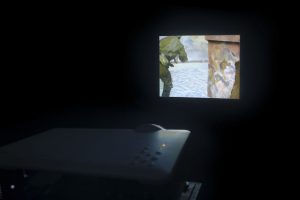
Storming of Berlin Sturm auf Berlin
Galerie Anita Beckers, Frankfurt am Main 2010
2 Channel Video Installation / Exhibition Views
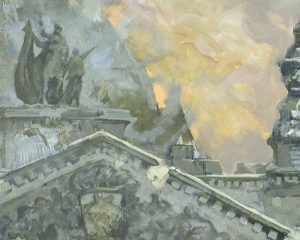
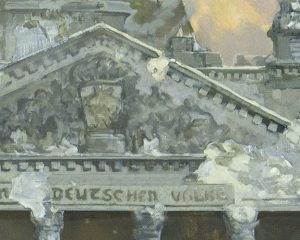
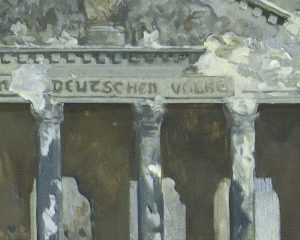
Storming of Berlin. Diorama: View 1
Sturm auf Berlin. Diorama: Ansicht 1
Moscow 2009/10
Photographs / Digital Montage / Digital Video
Quicktime Movie H.264 / 1024×768 / 25 p
Mute. 1 h 20 min. Loop
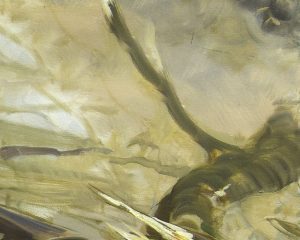
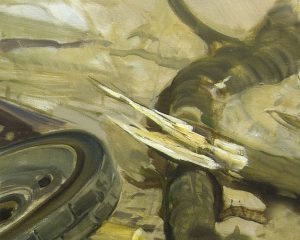
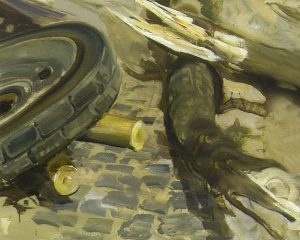
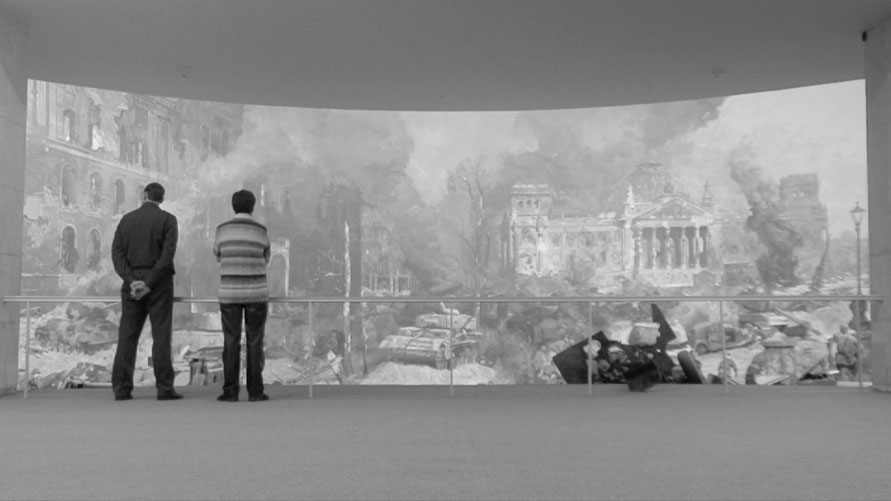
TEXT TRANSLATION:
Audio Recording in the Room Storming of Berlin. Moscow, November 2009
VOICE OF THE MUSEUM GUIDE:
… Children, in front of you is now the last battle, yes, the fiercest. You see the storming of Berlin.
The Operation “Berlin” started on April 16th, 1945.
During our advance, we have beaten the enemy and moved immediately on to directly storming Berlin.
You see in front of you April 30th. Only after two weeks, we succeeded in approaching the centre of the city, towards Königsplatz (King’s Square). In front of you lies the Königsplatz. It is blocked with Fascist tanks and rutted by trenches. The enemy built barricades in order to bar the way of the Russian army: our tanks, our cannon and our soldiers.
But is there around the world any such fire, such agonies, such a vigour that is greater than the Russian power?
Here are the units of the 3rd Guards Army. Their commander is the Colonel General Vasily Ivanovich Kuznetsov, of whom I already spoke at the first diorama. To him the privilege was granted to conquer the Reichstag, which you can see in the centre of the square.
During peacetime, children, the German Parliament used to work in this building, and now it is the last stronghold of Berlin, where the most loyal, most fanatic units of the SS (Protection Squadron), about 6,000 soldiers, assemble. They are armed to the teeth, and they secure the window openings and doors.
Under major efforts, we have spearheaded our way to the centre of the city.
On the left, look, way over there, a bridge, the Moltke-Bridge over the Spree, one of previously six bridges, that remained. We go past the burnt out buildings of the Gestapo (Secret State Police) and of the des General Staff and start storming the Reichstag.
All day long, we have assaulted the Reichstag, and on the evening of April 30th, at eleven o’clock, a severe attack is launched. At first, 76-mm-(divisional)-guns were deployed, then 45-mm-guns followed and after the third assault, we succeeded in advancing to the heart of the Reichstag and there we fought on.
At the fore, in the trench, you see three combatants with the red flag. On the left stands Colonel Zintchenko, Commander of the 756th Riflemen Regiment of the 3rd Guards Army. He hands the flag to two of his combatants, his two friends, to Sub-Sergeant Meliton Kantaria, a Georgian by nationality, and to the Russian Sergeant Mikhail Yegorov with the following words: “This flag of the Soviet Combatant of the 3rd Guards Army – you have to hoist it over the Reichstag as a symbol that the war is over.” And these scouts together with riflemen fought their way to the roof equipped with submachine guns and mounted the flag above the pediment of the east-wall on April 30th, at 21:50 hours.
And on May 2nd, after Berlin had capitulated, they carry the flag to the cupola, and our victory shines in the firmament of the blue May sky. And the world does not gaze at the Reichstag, but at Russia, at Mother Russia. It was her. Her people had defeated with this battle the SS and the other vermin and thus returned peace to the great Russia.
On the left hand side of the Reichstag, in the wads of smoke, stands the New Reich Chancellery of Adolf Hitler. The Reich Chancellor, who ignited World War II, had shot himself on April 30th, and his body had been burned.
Children, next to the Brandenburg Gate, on the rightmost side, the following scene had been observed at the end of April: There was gunfire, a small group of German women hurried back and forth with their children in search for a cover. At the sight of civilian population, our side ceased fire. The Germans, however, shot at their own people. One of the women, fatally hit, fell already down, and a girl of about four years started looking around and screamed for her mother. Out of our trench, Staff Sergeant Ivan Odarchenko quickly emerged. He came, took the girl, carried it off, made another step. And at that moment another German burst of fire went off.
And the staff sergeant dropped down and five days later he died. His death certificate could not be sent to anybody: Followers of Hitler had already wiped out his whole family in the first months of the war.
During the night to May 9th, at the Berlin suburb of Karlshorst, the documents on the unconditional surrender were signed. In the name of the Soviet people Marshal Zhukov signed and on behalf of the Germans the General Field Marschal Keitel.
And the Great Patriotic War was at an end.
And after the war, our sculptor Yevgeny Vuchetich set up a monument at the Treptower Park, Berlin, for the fallen Soviet soldier, the conqueror holding the rescued girl in his arms.
SWITCHING-ON THE PUBLIC ADDRESS SYSTEM:
Live Sound Reproduction / Radio Voice
… This is Moscow. From the Soviet Information Bureau:
Today on May 2nd, after persistent street fights, the armed forces of the 1st Belorussian Front, under the command of the Soviet Marshal Zhukov, could with the support of the armed forces of the 1st Ukrainian Front, under the command of the Soviet Marshal Konev, shatter the resistance of the Berliner group of the German armed forces and seized ultimately power over the capital of Germany, the city of Berlin …
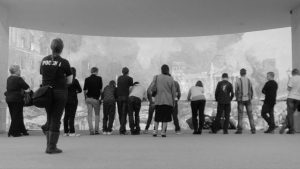
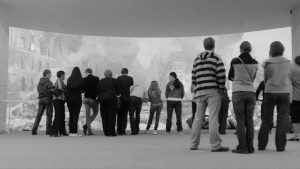
Storming of Berlin. Diorama: View 2
Sturm auf Berlin. Diorama: Ansicht 2
Moscow 2009
Apple HDV / Quicktime Movie H.264 / 1920×1080 / 25p
Partially Sound. 1 h 30 min. Loop